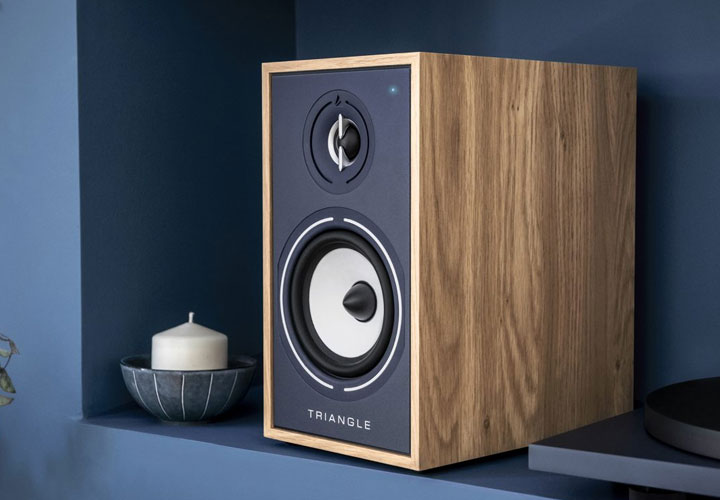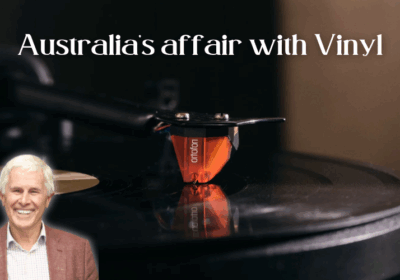It is just over 60 years since the very first stereo sound systems became available for home use, yet many modern Australian homes do not have one. This is because increasingly, Australians are instead listening to music in their homes using a single, small all-in-one device that contains an amplifier, a couple of speakers, probably a radio of some kind and sometimes a compact disc player. Recent models will likely have a wireless link, so they can play music from your phone, or via your internet connection.
REVIEWED: Triangle Borea BR03 BT Loudspeakers by Greg Borrowman
The primary problem with these single-box systems is that although they often have the separate ‘left-channel’ and ‘right-channel’ speakers that are required in order to reproduce stereo sound, and they claim to be ‘stereo’ devices, their speakers are mounted too close together to be able to create a true stereo image unless you are within one metre of them. To compensate for this shortcoming, their manufacturers use clever electronics to manipulate the audio signals to give the illusion that the sound you hear is not coming from the system itself. The result is sound that may seem ‘surround-like’ but it is not true stereophonic sound.
But there’s another problem with these small single-box systems, which is that the speakers they contain are too small to be able to deliver the lowest musical frequencies with any degree of authority and have a very small range of cone movement, which means that midrange distortion will increase in lock-step with every increase in volume level.
Despite all these short-comings, these single-box systems have become popular because until very recently, the only alternative has been to buy a complete hi-fi stereo system, which comprises not only a pair of separate loudspeakers, but also one or more electronic components as well — an amplifier to drive the speakers, and another component for playing CDs or to connect to your home’s computer network, or your phone. Increasingly, people are preferring not to do this.
Now there’s an alternative that delivers true stereo sound, impressive low-frequency performance and undistorted midrange sound even at high listening levels. Triangle, a company that has been manufacturing loudspeakers for more than 40 years in Soissons, France, has built all the electronics you need into one of its award-winning bookshelf loudspeaker designs, the Borea BR03, and called this enhanced version the Borea BR03 BT, where the BT stands for Bluetooth (Version 5.0 aptX).
The Equipment
The Borea BR03 BT is a two-way system that marries a 165mm diameter bass/midrange driver with a 30mm diameter soft fabric dome tweeter. The tweeter is inset deep into the baffle, which not only provides a degree of physical protection, but also to enable a degree of horn-loading, which increases the tweeter’s efficiency. Addition physical protection for the soft dome diaphragm is provided by two vertically-orientated ‘arms’ though their primary purpose is to enhance dispersion and improve phase response. Triangle claims system efficiency is a very high 90dBSPL.
All the system’s electronics are contained in the right-channel speaker of the stereo pair, making it the ‘active’ one of the two that has to be connected to 240V mains power. The left channel speaker is completely passive, and must be linked to the right channel speaker using conventional speaker cable that Triangle supplies. (Rather confusingly, the illustration in the Owner’s Manual incorrectly shows the active speaker as being on the left!) Triangle rates each of the two amplifiers inside the Borea with a power output of 60 watts.
In addition to being able to play music via Bluetooth, the active Borea loudspeaker has a pair of RCA analogue inputs that can be switched between ‘line’ and ‘phono’ so you can make a wired connection to a CD player (or any other component with a line level output) or to a turntable. It also has a 3.5mm stereo auxiliary phone socket to enable you to connect a mobile phone that does not have Bluetooth, or a portable music player of some type. There are also two digital inputs, one coaxial (via RCA) and the other optical (via Toslink).
A line-level subwoofer output is provided so you can easily connect a powered subwoofer to increase and extend the low-frequency response. You might not care to do this if you’re using these speakers only for music, but you would certainly consider this option if you’re using these speakers not only for music, but also to improve the sound of the inadequate speakers built into your TV. That said, there’s a very good argument for using these speakers to improve your TV sound even without a subwoofer, because they sound much better than any TV or TV soundbar I have ever heard.
A multi-function rotary control on the rear panel can be used to select your desired input (by pressing it inwards) or to adjust volume, but since this will likely be awkward to access once you’ve positioned the speakers, Triangle provides a small hand-held remote to control these functions. The remote also has controls that enable you to switch the system on and off, adjust the levels of bass and treble, activate a loudness circuit to make the sound more balanced when listening at low levels, mute the audio signal completely, and adjust the brightness of the LED on the front baffle of the right-channel speaker whose colour shows the active input.
Rather unusually, the remote control does not communicate with the speaker via infra-red light, but instead via radio frequencies. This means that you do not need to point the remote control at the speakers — or even be in the same room! — for it to work, but more importantly, it means that if you are playing music via Bluetooth, you can use the remote’s controls to skip forward and backwards through the tracks on your playlist, or stop or pause play, rather than having to do this using your phone.
As with all Triangle loudspeakers, the Borea BR03 BT speakers are beautifully finished and look fantastic in all three colour options — walnut, black and white. If you could look inside the BR03 BT’s cabinet you’d find a curious structure that Triangle calls a ‘Driver Vibration Absorption System’ or DVAS. Its aim is firstly to absorb driver vibration before it reaches the cabinet itself and secondly to reduce the cabinet’s ability to vibrate, so that if any vibration goes get past the first defence, it’s negated by the second. To do this, Triangle uses what it describes as “perforated internal panels in MDF and EVA foam, thus stiffening the transducer/cabinet combination and reducing vibration to ensure neutrality and clarity when listening, due to there being no colouration or structure noise.”
Essentially DVAS is a bracing system that braces both the drivers and the cabinet walls, but at the same time decouples the braces themselves from both. Each cabinet measures 206×360×314mm. Unlike some other speakers in Triangle’s range, the Borea BR03 BT is made in China.
Listening Sessions

Although the Borea BR03 BT speakers are self-powered, I could hear that the drivers are inherently efficient because of the lively, energetic sound quality they deliver, which is the result of the bass/midrange cones being able to start up and stop so quickly, due to their low mass and the magnetic circuit created by the voice-coils and driver magnets. This high efficiency also means that the two 60-watt amplifiers inside the Borea are easily able to easily have the drivers creating very high in-room sound pressure levels without any overload or distortion.
The Mayo Nakano Piano Trio’s outstanding album ‘Miwaku’ is a beautifully recorded work that sounds amazing in any of the various formats in which it’s available. Recording engineer Masamichi Ohashi has perfectly captured not only the sound of Nakano’s grand piano but also that of Yoshio Ikeda’s double bass and Takamochi Baba’s unusually-outfitted drum kit.
Listening to the title track, I was surprised that the Borea BR03 BTs were able to deliver the notes in the lower octaves of the Bosendorfer’s keyboard so effectively and with such tonal accuracy, because this is rare to find with a small two-way speaker design. And when Ohashi and Ikeda both play the same deep bass notes in unison, the Borea BR03 BTs were able to delineate the two different tones beautifully well.
Further on in the track, when Ohashi is alternately stabbing and caressing the keys under the fingers of her right hand, the Boreas revealed the differences in sound with laser-like accuracy. Baba uses his entire cymbal complement on this track, and the sound of all was reproduced realistically by the Triangle’s soft-dome tweeter with a sweet, pure tonal quality and none of that hard ‘edge’ that you can often hear from tweeters fitted with hard domed diaphragms. The ‘tinkle’ of the sound when Ohashi plays in the piano’s topmost octave is simply glorious.
The bass from the Triangle Borea BR03 BTs was equally impressive on the opening track of Maggie Rogers’ latest album, ‘Surrender’, particularly the synth bass and kick drum, but I was playing the album to hear how they delivered Rogers’ voice, and they did this to perfection. Her silky sweet, soupy rich delivery on Overdrive contrasted beautifully with her rawer, edgier, more nasal delivery on That’s Where I Am (except when she switches to her flawless high register).
For male vocal I listened to Harry Styles. Not his latest album, of which I’m not so much a fan, but ‘Fine Line’, from back in 2019. The first thing I noticed was the effortless delivery by the Borea’s tweeters of the tinkling highs that kick off the opener, Golden. Once into the track, Styles’ thin trademark tenor voice was clearly evidenced and instantly recognisable thanks to the accurate midrange delivery of the Triangles.
For evaluating a lower-pitched male vocal, I spun up David Bowie, whose name was on my radar because he was very recently listed as being the best-selling vinyl artist of the 21st century, despite having died in 2016. But it wasn’t vinyl I spun, it was the 2CD ‘Best of Bowie’ set from 2002, which does have almost all his best songs (though some of the best were left off the particular version that was released here in Australia). The Triangle Borea BR02 BTs again performed superbly, whether it was delivering the atmospherics of Space Oddity, the syncopated, weird sound effects of The Man Who Sold the World, or the sheer vocal brilliance Bowie demonstrates in such songs as Changes and Life on Mars. I confess to being shocked when Queen’s Under Pressure suddenly burst from the BR02 BTs — I had completely forgotten he’d covered it (and should not have).
Conclusion
The passive version of the Triangle Borea BR03 BT was named ‘Stand-mount Loudspeaker of the Year’ by Hi-Fi+ magazine, awarded 5 Stars by What Hi-Fi magazine and an integral part of the system that won a ‘Best Buy Home Theatre System’ award from the Expert Imaging and Sound Association (EISA) which uses expert judges from 29 countries around the world to determine its winners.
These new Triangle Borea BR03 BT active speakers cost just $300 more than the passive version, sound every bit as good, are completely self-contained, so there’s no need to spend money on an amplifier — or waste any shelf space on one — and you can send music to them wirelessly from your mobile and/or connect up to four other audio sources, including a TV and a turntable. If all that doesn’t have you thinking to yourself that these speakers are an amazing bargain, then you have not been paying attention, because they are both: amazing and also a bargain!
# greg borrowman
Price $1,200 per pair – Click here to purchase online
Len Wallis Audio has commissioned the services of Greg Borrowman, who has been the editor of Australian Hi-Fi magazine for over four decades, to write a number of subjective based reviews on the products that we carry. While Greg is paid for this service it is under the assumption that there is no editorial pressure from any one at Len Wallis Audio – if he finds fault with the product it is expected that he says so.





